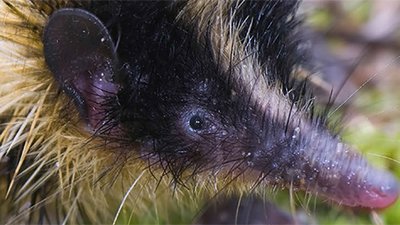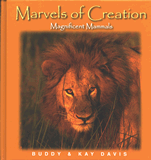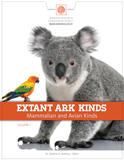
The Cheetah Classifying Conundrum
Are Cheetahs Really Part of the Feline Created Kind?
In Genesis 1:20–25, God tells us he created every animal according to its kind. Unlike the term “species” which references (generally) the most specific level of biological taxonomy, the created kinds discussed in Scripture typically fall at the family level of classification—sometimes order, sometimes genus. That means many species often comprise a single biblical kind. For example, today’s gray wolves, coyotes, and domestic dogs may all be classified as different species of canines, but they belong to a single created kind—the canine kind.
During creation week 6,000 years ago, God did not create gray wolves, coyotes, or domestic dogs. He created generic canines that carried vast genetic potential which has now filtered down into the many species of canines we see today. Other than studying their genetics, the best proof that these animals are related is the fact that they can hybridize. Wolf dogs, coydogs, and coywolves are relatively common occurrences, both under human care and in the wild. While there is a lot of variation and hybridization within canines, they are all still canines. They never turn into a new kind of animal. Kinds will never turn into new kinds, and you will never see one kind produce offspring with another kind. Canines will never breed with felines to create a new kind of animal.
10 of the 14 extant feline genera from largest to smallest are connected genetically through hybridization.
Speaking of felines, cats are also an excellent example of the kinds concept. While you won’t find tigers, today’s largest cats, hybridizing with your domestic cats at home (the tigers are more likely to eat the house cats), these two drastically different felines are connected through hybridization data. Tigers, lions, leopards, and jaguars can all interbreed. Leopards and jaguars can breed with cougars. Cougars can breed with ocelots, and ocelots can breed with domestic cats. Domestic cats can also breed with African wildcats, Asian leopard cats, caracals, Chinese mountain cats, European wildcats, fishing cats, Geoffroy’s cats, jungle cats, margays, oncillas, sand cats, and servals. Embryos have also been formed between domestic cats and Pallas’s cats. European wildcats can breed with margays, and margays can breed with ocelots. Ocelots can breed with bobcats, and bobcats can breed with lynxes. Therefore, 10 of the 14 extant feline genera from largest to smallest are connected genetically through hybridization!
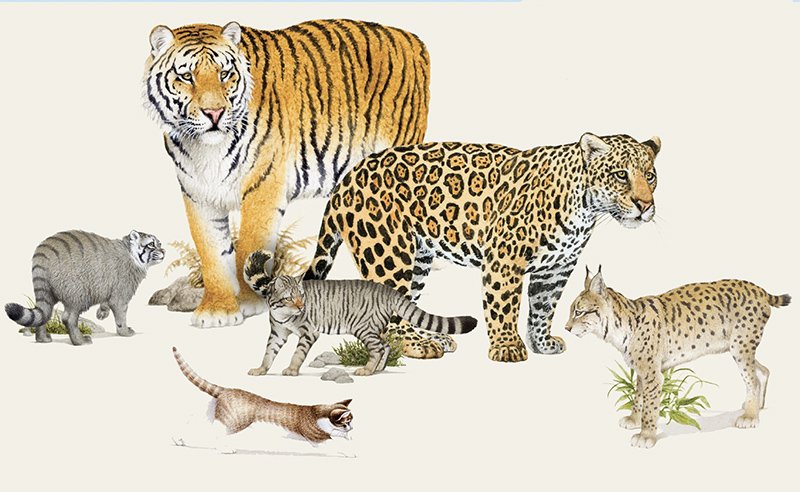
Image courtesy of Answers magazine.
There are four exceptions. Neofelis (clouded leopards), Pardofelis (marbled cats), and Catopuma (Asian golden cats and bay cats) do not have any hybridization data, but they are indisputably cats which leaves Acinonyx—the cheetahs. There are no known hybrids with the world’s fastest land animal. Cheetahs also seem to lack some universal feline characteristics. Are we sure that cheetahs really belong to the feline kind?
The evidence says yes. Hybridization data is not the only factor determining genetic relation. Not only do cheetah genetics reveal that they fall well within the feline kind but their morphology does too. However, two common myths lead some people to question whether they’re really cats. Let’s debunk those common cheetah misconceptions!
Myth: Cheetahs don’t have retractable claws.
Retractable claws are one of the most prominent shared traits among feline species.
Fact: Yes, they do! Retractable claws are one of the most prominent shared traits among feline species. In fact, cheetahs do possess semiretractable claws. Because they are regularly running up to 60 mph to catch prey, having semiretractable claws gives them extra traction at high speeds, much like cleats do for human athletes. Their loss of the ability to fully retract their claws is beneficial for their lifestyle.
Myth: Cheetahs are the only “big cat” that can’t roar/are the only “big cat” that can purr.
Fact: Although they are certainly larger than the house cats we’re used to, cheetahs are actually not “big cats”! The term “big cat” refers to species in the Panthera genus, which includes tigers, lions, jaguars, leopards, and snow leopards. All but the snow leopard are capable of roaring because the epihyal bone in the voice box is replaced by a stretchy ligament that elongates the larynx and creates a wider range of pitch. The more the ligament stretches, the lower noises become, and the large, fatty vocal cords create deeper sounds. Despite being big cats, snow leopards cannot truly roar because they lack that layer of fleshy, elastic tissue on their vocal cords, but they can purr. Some scientists have proposed reclassifying the snow leopard into its own genus due to this anomaly. Cheetahs and all other “small cats” in the subfamily Felinae have voice boxes with a bony hyoid arranged in a fixed structure, which limits their range of sounds and prevents roaring. However, they can purr like snow leopards, while other big cats cannot.
If they’ve got the morphology of cats, why can’t cheetahs hybridize with other cat species? Genetically, the closest relatives of cheetahs are cougars and jaguarundis, both of which live in the Americas while cheetahs live in Africa and Asia. They do not interact in the wild. Cougars can certainly hybridize—they have with three other cat species—but never with cheetahs, even under human care.
Cheetahs are extremely inbred.
The likely reason why cheetahs do not hybridize with other cat species is that cheetahs are extremely inbred. Inbreeding occurs when closely related individuals repeatedly breed which results in their genetics becoming overexpressed in a population. To demonstrate just how inbred cheetahs are, take a look at the photo below of the genetic markers of three different cats.
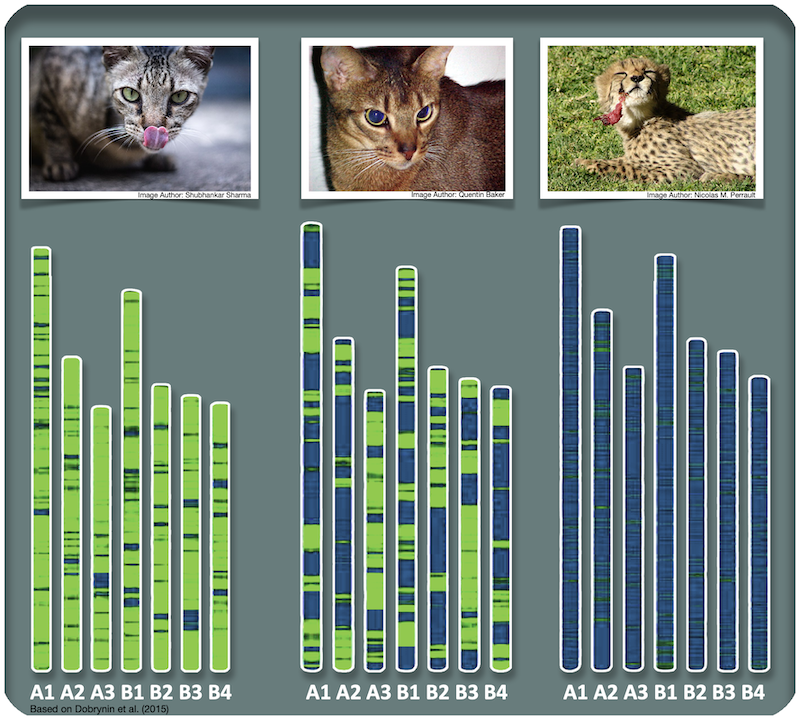
Image credit: Cameron Suter (AiG). Derived from P. Dobrynin, S. Liu, G. Tamazian et al., “Genomic legacy of the African cheetah, Acinonyx jubatus,” Genome Biol 16, 277 (2015), https://doi.org/10.1186/s13059-015-0837-4.
All cheetahs today are the genetic equivalent of cousins!
The cat on the left is a feral cat from Russia. The cat in the middle is a purebred Abyssinian. The cat on the right is a cheetah. The green represents heterozygous genetics indicating variation, while the blue represents homozygous genetics indicating inbreeding. You will see there is very little genetic variation among cheetahs. In fact, all cheetahs today are the genetic equivalent of cousins! Their immune systems are essentially identical—so much so, that you can graft skin from one cheetah onto any other cheetah without any ill effects!
How did cheetahs become so inbred? It’s likely due to a genetic bottleneck somewhere in their past. A bottleneck effect occurs when something (such as catastrophes, deaths, geographic separation, diseases, infertility, etc.) begins narrowing down the number of individuals, and therefore genetic variation, in a population. Over time, fewer and fewer genetic differences get passed on to each succeeding generation. Formerly rare alleles suddenly become more common, often resulting in serious defects. For example, 60% of cheetahs now suffer from palatal erosion, a degenerative disease that breaks down the palates of cheetahs as they age, leading to their untimely demise. Other unfortunate effects of this bottlenecking on cheetahs include increased spermatozoan defects (cheetah sperm quality is often below the threshold of infertility), increased juvenile mortality rates, and increased susceptibility to infections and disease.
While cheetahs are certainly unique among the cat kind, their morphology and genetics currently provide strong evidence that they belong to the feline created kind.
What caused this bottleneck effect? Looking at biblical history, we know that God brought Noah a pair of cats representing the feline kind to board the ark and survive the global flood (Genesis 6:19–20, 7:2–3). After the ark landed on the mountains of Ararat (Genesis 8:4) in Asia Minor and the animals disembarked, God commanded them to be fruitful and multiply and fill the earth (Genesis 8:17). Fossil evidence reveals that the descendants of the cats on Noah’s ark traveled throughout the world. Temporary land bridges during the ice age following the flood allowed cats to cross into the Americas. One lineage became the now extinct American cheetahs, which were very physically similar to the cheetahs we see today. We find their fossils in the same range as modern cougars. It appears that one of the American cheetah lineages then crossed back over into Asia and Africa, likely creating the bottleneck effect that has resulted in the modern inbred cheetahs we see today.
In conclusion, while cheetahs are certainly unique among the cat kind, their morphology and genetics currently provide strong evidence that they belong to the feline created kind. Scientific knowledge increases every day, and our understanding of cheetahs may certainly change in the future. What we can be certain of is that God’s Word never changes and that he is the Creator of all things, including the animal kind that contains the cheetahs. While they are sadly affected by the results of human sin in our fallen world, we also have hope that one day creation will be restored. There will be new heavens and a new earth where creation will be perfect once more (Isaiah 11:6–8).
Recommended Resources

Answers in Genesis is an apologetics ministry, dedicated to helping Christians defend their faith and proclaim the good news of Jesus Christ.
- Customer Service 800.778.3390
- © 2024 Answers in Genesis

